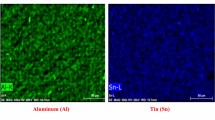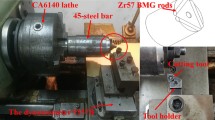Abstract
Bulk metallic glass (BMG) is one of the predominant materials that are progressively used in the aerospace, medical devices, electronics, sporting goods, and engineering materials. Making of components by BMG is still confrontation. Conventional methods of machining are restricted in use due to more tool wear and slower processing efficiency. Non-traditional methods of machining have been widely used for processing hard materials. Wire electrical discharge machining (WEDM) is one among the promising approaches of machining for hard and conductive materials, especially for the new BMG metal material. The preliminary aim of this exploration is to predict the temperature field distribution using the modified Gaussian heat source mode during WEDM multi-pulse discharge process. The effects of various variables (pulse off time and peak current) on the pit depth and surface roughness were investigated. The influence of the main parameters on the machining performance was investigated using Taguchi’s orthogonal arrays. The excellent surface quality is obtained at the optimized condition of a pulse on time of 4 μs, pulse off time of 25 μs, and a peak current of pulse on time.






















Similar content being viewed by others
Abbreviations
- T :
-
Temperature (K)
- t :
-
Time (s)
- c :
-
Specific heat capacity of the material (J/(kg∙K))
- k :
-
Thermal conductivity of the material (W/(m2·K))
- ρ :
-
Material density (kg/m3)
- R(t):
-
Radius of the heat source (m)
- I :
-
Discharge current (A)
- t on :
-
Pulse on time (s)
- q max :
-
Maximum heat flow
- r :
-
Radial cylindrical coordinate
- z :
-
Axial cylindrical coordinate
- R pc :
-
Radius of the discharge channel (m)
- η :
-
Energy distribution factor
- U :
-
Discharge maintenance voltage (V)
- x i :
-
Distance between discharge points (m)
- Ra:
-
Surface roughness (μm)
- r c :
-
Radius of the crater (μm)
- r s :
-
Radius of the discharge channel (μm)
- s :
-
Depth of the crater (μm)
- CE :
-
Cutting efficiency
- T :
-
Processing time (s)
- d :
-
Workpiece diameter
- ON :
-
Pulse on time (μs)
- OFF :
-
Pulse off time (μs)
- IP :
-
Peak current (A)
References
Chang WJ, Li XX, Yang HD, Zhang JS, Zhang JC, Tang HH, Chen SH (2022) On the wire EDM of metastable atomic structured bulk metallic glasses. Int J Adv Manuf Technol 120:5411–5430. https://doi.org/10.1007/s00170-022-09068-5
Zhang L, Huang H (2018) Micro machining of bulk metallic glasses: a review. Int J Adv Manuf Technol 100:637–661. https://doi.org/10.1007/s00170-018-2726-y
Xing LQ, Li Y, Ramesh KT, Li J, Hufnagelet TC (2001) Enhanced plastic strain in Zr-based bulk amorphous alloys. Phys Rev B 64:180201. https://doi.org/10.1103/PhysRevB.64.180201
Zhang J, Park JM, Kim DH, Kim HS (2007) Effect of strain rate on compressive behavior of Ti45Zr16Ni9Cu10Be20 bulk metallic glass. Mater Sci Eng C 449:290–294. https://doi.org/10.1016/j.msea.2006.02.405
Yavari AR, Lewandowski JJ, Eckert J (2011) Mechanical properties of bulk metallic glasses. MRS Bull 32:635–638. https://doi.org/10.1557/mrs2007.125
Guo YB, Klink A, Fu CH, Snyder J (2013) Machinability and surface integrity of Nitinol shape memory alloy. CIRP Ann Manuf Technol 62:83–86. https://doi.org/10.1016/j.cirp.2013.03.004
Zhao YZ, Li JF, Guo K, Sivalingam V, Sun J (2020) Study on chip formation characteristics in turning NiTi shape memory alloys. J Manuf Process 58:787–795. https://doi.org/10.1016/j.jmapro.2020.08.072
Ishfaq K, Farooq MU, Anwar S, Ali MA, Ahmad S, El-Sherbeeny AM (2020) A comprehensive investigation of geometrical accuracy errors during WEDM of Al6061-7.5%SiC composite. Mater Manuf Process 36(3):362–372. https://doi.org/10.1080/10426914.2020.1832683
Wessels V, Grigoryev A, Dold C, Wyen CF, Roth R, Weingärtner E, Pude F, Wegener K, Löffler JF (2012) Abrasive waterjet machining of three-dimensional structures from bulk metallic glasses and comparison with other techniques. J Mater Res 27:1187–1192. https://doi.org/10.1557/jmr.2012.36
Yeo SH, Tan PC, Aligiri E, Tor SB, Loh NH (2009) Processing of zirconium-based bulk metallic glass (BMG) using micro electrical discharge machining (Micro-EDM). Mater Manuf Process 24:1242–1248. https://doi.org/10.1080/10426910903129661
Abdul-rani AM, Aliyu AAA, Hastuty S, Ginta TL, Rao TVVLN, Ali S (2018) Enhancing surface quality of Zr-Cu-Ni-Ti-Be through hydroxyapatite mixed EDM for potential orthopedic application, vol 2035. AIP Publishing, p 080010. https://doi.org/10.1063/1.5075609
Xu JK, Pei QQ, Lian Z, Yu P, Ma GS, Yu HD (2019) Experimental study on wire-electrical discharge machining of zirconium-based metallic glass. Mater Res Express 6:115214. https://doi.org/10.1088/2053-1591/ab2773
Chiang KT, Chang FP (2006) Optimization of the WEDM process of particle-reinforced material with multiple performance characteristics using grey relational analysis. J Mater Process Technol 180:96–101. https://doi.org/10.1016/j.jmatprotec.2006.05.008
Chaudhari R, Vora JJ, Prabu SSM, Palani IA, Patel VK, Parikh DM, de Lacalle LNL (2019) Multi-response optimization of WEDM process parameters for machining of superelastic nitinol shape-memory alloy using a heat-transfer search algorithm. Materials 12:1277. https://doi.org/10.3390/ma12081277
Liu ZD, Wang XZ, Cao ZL (2015) Influence of discharge energy on EDM ablation. Int J Adv Manuf Technol 83:681–688. https://doi.org/10.1007/s00170-015-7623-z
Esteves PMB, Wiessner M, Costa JVMR, Sikora M, Wegener K (2021) WEDM single crater asymmetry. Int J Adv Manuf Technol 117:2421–2427. https://doi.org/10.1007/s00170-021-07023-4
He WB, He ST, Du JG, Ming WY, Ma J, Cao Y, Li XK (2019) Fiber orientations effect on process performance for wire cut electrical discharge machining (WEDM) of 2D C/SiC composite. Int J Adv Manuf Technol 102:507–518. https://doi.org/10.1007/s00170-018-03210-y
Tlili A, Ghanem F, Salah NB (2015) A contribution in EDM simulation field. Int J Adv Manuf Technol 79:921–935. https://doi.org/10.1007/s00170-015-6880-1
Yue XM, Yang XD (2020) Molecular dynamics simulation of material removal process and mechanism of EDM using a two-temperature model. Appl Surf Sci 528:147009. https://doi.org/10.1016/j.apsusc.2020.147009
Zhang SF, Zhang WC, Chang H, Liu Y, Ma FJ, Yang DP, Sha ZH (2019) Study of the thermal erosion, ejection and solidification processes of electrode materials during EDM. Eng Appl Comput Fluid Mech 13:1153–1164. https://doi.org/10.1080/19942060.2019.1676313
Tang L, Ji Y, Ren L, Zhai KG, Huang TQ, Fan QM, Zhang JJ, Liu J (2019) Thermo-electrical coupling simulation of powder mixed EDM SiC/Al functionally graded materials. J Adv Manuf Technol 105:2615–2628. https://doi.org/10.1007/s00170-019-04445-z
Ming W, Zhang GJ, Li H, Guo JW, Zhang Z, Huang Y, Chen Z (2014) A hybrid process model for EDM based on finite-element method and Gaussian process regression. Int J Adv Manuf Technol 74:1197–1211. https://doi.org/10.1007/s00170-014-5989-y
Hou SJ, Bai JC (2021) A geometric prediction model of surface morphology in micro-EDM considering stochastic characteristics of discharge crater size. Int J Adv Manuf Technol 117:1147–1162. https://doi.org/10.1007/s00170-021-07795-9
Gostimirovic M, Radovanovic M, Madic M, Rodic D, Kulundzic N (2018) Inverse electro-thermal analysis of the material removal mechanism in electrical discharge machining. Int J Adv Manuf Technol 97:1861–1871. https://doi.org/10.1007/s00170-018-2074-y
Wang J, Sánchez JA, Izquierdo B, Ayesta I (2020) Influence of AISI D2 workpiece roughness on heat partition and plasma channel radius in the WEDM process. Metals 10:1360. https://doi.org/10.3390/met10101360
Tang L, Ren L, Zhu QL (2018) EDM multi-pulse temperature field simulation of SiC/Al functionally graded materials. Int J Adv Manuf Technol 97:2501–2508. https://doi.org/10.1007/s00170-018-2136-1
Dibitonto DD, Eubank PT, Patel MR, Barrufet MA (1989) Theoretical models of the electrical discharge machining process. I. A simple cathode erosion model. J Appl Phys 66:4095–4103. https://doi.org/10.1063/1.343994
Eubank PT, Patel MR, Barrufet MA, Bozkurt B (1993) Theoretical models of the electrical discharge machining process. III. The variable mass, cylindrical plasma model. J Appl Phys 73:7900–7909. https://doi.org/10.1063/1.353942
Philip JT, Mathew J, Kuriachen B (2020) Numerical simulation of the effect of crater morphology for the prediction of surface roughness on electrical discharge textured Ti6Al4V. J BRAZ SOC MECH SCI 42:248. https://doi.org/10.1007/s40430-020-02321-6
Shahri HRF, Mahdavinejad R (2018) A novel method towards approximation of the temperature distribution in electric discharge machining of Ti-6Al-4V by up-scaling approach. Int J Adv Manuf Technol 96:503–520. https://doi.org/10.1007/s00170-018-1578-9
Nowak S, Perrière L, Dembinski L, Tusseau-Nenez S, Champion Y (2011) Approach of the spark plasma sintering mechanism in Zr57Cu20Al10Ni8Ti5 metallic glass. J Alloys Compd 509:1011–1019. https://doi.org/10.1016/j.jallcom.2010.09.158
Funding
The work described in this paper was supported by the Fundamental Research Funds for the Central Universities (grant no. JZ2022HGTB0247).
Author information
Authors and Affiliations
Contributions
Huohong Tang: conceptualization, methodology, writing—original draft. Maohu Cheng: visualization, data curation. Weijie Chang: validation, supervision, conception, writing—review and editing. Yingyue Yin: validation, supervision, conception, writing—review and editing. Bolin Dong: software, investigation. Qin Yang: visualization, data curation. Shunhua Chen: methodology, supervision, funding acquisition.
Corresponding authors
Ethics declarations
Competing interests
The authors declare no competing interests.
Additional information
Publisher’s note
Springer Nature remains neutral with regard to jurisdictional claims in published maps and institutional affiliations.
Rights and permissions
Springer Nature or its licensor (e.g. a society or other partner) holds exclusive rights to this article under a publishing agreement with the author(s) or other rightsholder(s); author self-archiving of the accepted manuscript version of this article is solely governed by the terms of such publishing agreement and applicable law.
About this article
Cite this article
Tang, H., Cheng, M., Chang, W. et al. Effects of processing parameters on the surface roughness of Zr-based bulk metallic glass processed by wire electrical discharge machining. Int J Adv Manuf Technol 128, 41–56 (2023). https://doi.org/10.1007/s00170-023-11829-9
Received:
Accepted:
Published:
Issue Date:
DOI: https://doi.org/10.1007/s00170-023-11829-9




